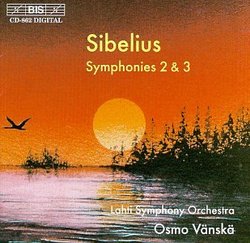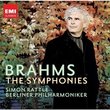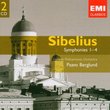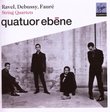| All Artists: Jean Sibelius, Osmo Vänskä, Lahti Symphony Orchestra Title: Sibelius: Symphonies Nos. 2 & 3 Members Wishing: 0 Total Copies: 0 Label: Bis Release Date: 8/5/2000 Album Type: Import Genre: Classical Style: Symphonies Number of Discs: 1 SwapaCD Credits: 1 UPC: 789368593026 |
Search - Jean Sibelius, Osmo Vänskä, Lahti Symphony Orchestra :: Sibelius: Symphonies Nos. 2 & 3
 | Jean Sibelius, Osmo Vänskä, Lahti Symphony Orchestra Sibelius: Symphonies Nos. 2 & 3 Genre: Classical
|
Larger Image |
CD DetailsSimilar CDs |
CD ReviewsSober Second, Very Fine Third Moldyoldie | Motown, USA | 03/27/2007 (4 out of 5 stars) "The Symphony No. 2 is probably Sibelius' most popular and it receives a very broad and expansive rendering here -- much too sober and polite to recommend for a novice. The limitations of the orchestra are apparent, but the performance is committed if somewhat episodic and lacking natural flow. My favorite recording of No. 2 is by John Barbirolli and the Royal Philharmonic on the Chesky label, which I'd wholeheartedly recommend. The No. 3 here is a personal favorite with a beautifully melodic and melancholy middle movement. This digital disc is also warmly and transparently recorded, adding the needed resonance to these mostly cool performances." Music that touches your soul D. Takeuchi | St. Cloud, MN United States | 04/07/2007 (5 out of 5 stars) "This must be one of the best Sibelius recordings. The second symphony must be a challenging piece, but Osmo Vanska takes great care of each detail that every time I listen to it, I am moved to near tears. It took me a while to get familiar with the music, though, as I am not a classical music academic. But be patient. Listen to it again and again, if you are a regular music lover like me. All the rest of Sibelius symphony recordings by Vanska and Lahti Orchestra on Bis label are recommended. Jean Sibelius: Violin Concerto in D minor (Original Version); Violin Concerto in D minor" Fascinating David Saemann | 07/10/2008 (4 out of 5 stars) "The Third Symphony is given a great performance here. Tempos are slightly on the slow side, which Vanska uses to give a sense of spaciousness to the reading. The important solos, particularly the winds in the second movement, are beautifully turned, while the finale lacks the driven quality some other conductors ascribe to it. I am less pleased with Vanska's version of the Second Symphony. It is beautifully prepared and played at sensible tempos. The clarity of the string writing is especially well rendered. Nevertheless, this is a Romantic symphony, and at times the string section of the Lahti orchestra appears overwhelmed. I miss the big gestures a great international ensemble can bring to this piece, as in the 1957 Ormandy/Philadelphia and later Levine/Berlin versions. Nevertheless, on its own terms this is a quite an enjoyable performance. The sound engineering is up to BIS's highest standards in the Third, clear and full sounding, with superb dynamics. The Second is very well recorded, too, with just a touch of fuzziness in fortissimos. I think there are better Sibelius Seconds out there, but this definitely is a disc worth hearing."
|

 Track Listings (7) - Disc #1
Track Listings (7) - Disc #1


